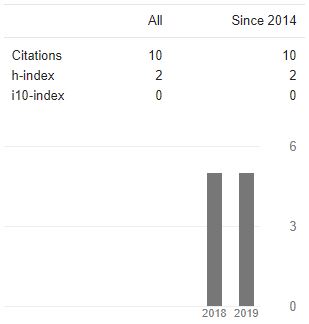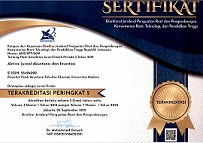PENGARUH FINANCIAL STABILITY, CHANGE IN AUDITORS, DCHANGE, CEO’s PICT PADA FRAUD DALAM PERSPEKTIF FRAUD PENTAGON
Abstract
This research aims to obtain empirical evidence about effectiveness of the
fraud pentagon are pressure, opportunity, rationalization, competence and arrogance in detecting financial statement fraud. The variables of the fraud pentagon that used is a pressure with proxy financial stability (ACHANGE), rationalization with change in auditor, competence with chnage in director’s, and arrogance with Frequent Number of CEO’s Picture . In this research to detecting financial statement fraud as the dependen variabel.
The population of this research is the industries companies listed in Indonesia stock exchange in 2015-2017. Data analysis was performed with the classical assumption and hypotesis testing using linear regression. The result of this research indicates that the financial stability (ACHANGE), change in auditor (CPA), change in directors (DCHANGE), Frequent Number of CEO’s Picture (CEOPICT) influence the financial statement fraud,
Keywords
Full Text:
PDFReferences
AICPA, SAS No. 99.2002. “Consideration of Fraud in a Financial Statement Audit, AICPA”. New York.
Albrecht, W. S. 2002. “Fraud Examination”. Mason, OH: Thomson-SouthWestern, United States of America.
Association of Certified Fraud Examiners. 2016. “Report to the nation on occupational fraud and abuse (2016 global fraud study)”. Retrieved from www.acfe.com/rttn/rttn 2016.pdf
Beasley, M.S., J.V. Carcello, D.R. Hermanson, dan T.L. Neal. 2010. “Fraudulent Financial reporting 1998 2007, an Analysis of U.S. Public Companies”. Committee of Sponsoring Organizations of the Treadway Commission. University of Tennessee.
Chen, K., dan R.J. Elder. 2007. Fraud Risk Factors and the Likelohood of Fraudulent Financial Reporting Evidence from Statement on Auditing Standards No. 43 in Taiwan. Diunduh 30 Agustus 2016. .
Crowe Horwarth. 2012. “The Mind Behind The Fraudsters Crime :Key Behavioral and Environmental Element”
Cressey, D. R. (1953). “Other People’s Money”. Montclair, NJ: Patterson Smith, pp.1- 300.
Ghozali, Imam. 2011. Aplikasi Analisis Multivariate dengan Program SPSS. Cetakan Keempat. Semarang: Badan Penerbit Universitas Diponegoro.
Kusumawardhani, P. (2013). Deteksi Financial Statement Fraud dengan Analisis Fraud Triangle pada Perusahaan Perbankan yang Terdaftar di BEI. Jurnal Akuntansi UNESA Vol. 1, No3
Loebbecke, J.K. , M.M. Eining dan J.J Willingham. 1989. Auditors Experience with Irregularities : Frequency Nature and Detectability. Auduting : A Journal of Practice & Theory, 9 (Fall) : 1-28
Martantya, & Daljono. (2013). Pendeteksian Kecurangan Laporan Keuangan melalui Faktor Risiko Tekanan dan Peluang (Studi Kasus pada Perusahaan Manufaktur yang mendapat Sanksi dari Bapepam periode 2002-2006). Diponegoro journal of accounting Vol. 2, No.2 ISSN(Online); 2337-3806, 1 -12.
Molida, Resti. 2011. Pengaruh Financial Stability, Personal Financial Need dan Ineffective Monitoring pada Financial Statement Fraud dalam Perspektif Fraud Triangle. Skripsi. Fakultas Ekonomi. Universitas Diponegoro, Semarang.
Sihombing, Kennedy Samuel, & Shiddiq Nur Rahardjo. 2014. “Analisis Fraud Diamond dalam Mendeteksi Financial Statement Fraud” : Studi Empiris Pada Perusahaan Manufaktur yang Terdaftar di Bursa Efek Indonesia (BEI). Journal of Accounting Fakultas Ekonomika dan Bisnis, Universitas Diponegoro. Semarang
Skousen, C. J., K. R. Smith, dan C. J. Wright. 2009. ”Detecting and Predecting Financial Statement Fraud: The Effectiveness of The Fraud Triangle and SAS No. 99.” Corporate Governance and Firm Performance Advances in Financial Economics, Vol. 13, h. 53-81.
Statement of Financial Accounting Standards No.1, (2006), " Conceptual Framework for Financial
Tessa, Chyntia G.,Puji Harto.(2016)” Fraudulent Financial Reporting: Pengujian Teori Fraud Pentagon Pada Sektor Keuangan Dan Perbankan Di Indonesia” Simposium Nasional Akuntansi XIX, Lampung.
Tuanakotta Theodorus. M.2013.”Audit Berbasis ISA (International Standar Auditing)”.Jakarta:Salemba Empat
Wolfe, David T and Dana R. Hermanson. 2014. “The Fraud Diamond : Considering the Four Elements of Fraud”. CPA Journal. 74.12 : 38-42
www.idx.co.id
Yesiariani, Merissa dan Isti Rahayu (2016) “Analisis Fraud Diamond Dalam Mendeteksi Financial Statement Fraud (Studi Empiris pada Perusahaan LQ-45 yang Terdaftar di Bursa Efek Indonesia Tahun 2010 - 2014)” Simposium Nasional Akuntansi XIX, Lampung.
DOI: http://dx.doi.org/10.53712/aktiva.v5i1.833
Refbacks
- There are currently no refbacks.
Indexing:
Member Of:
Reference Manager:
Published by Prodi Akuntansi Fakultas Ekonomi Universitas Madura
Jl. Raya Panglegur Km 3,5 Pamekasan
Phone: (0324) 322231
website: http://ejournal.unira.ac.id/index.php/jurnal_aktiva/index
Email: jaa.unira@gmail.com
AKTIVA by Universitas Madura is licensed under a Creative Commons Attribution 4.0 International License.












